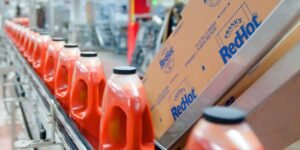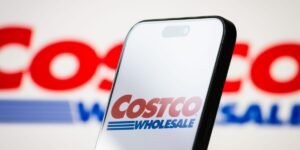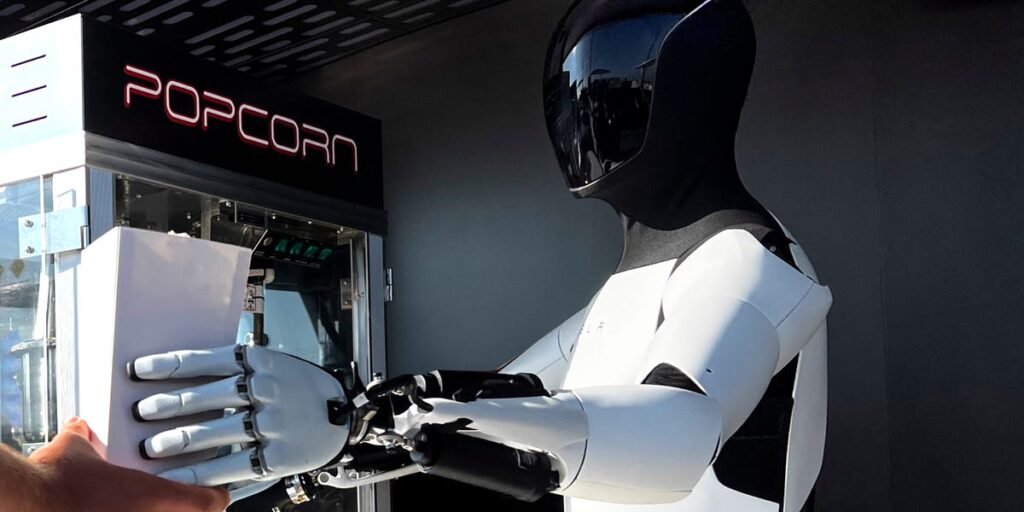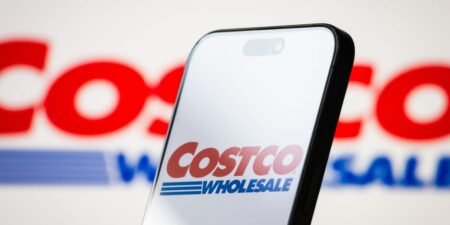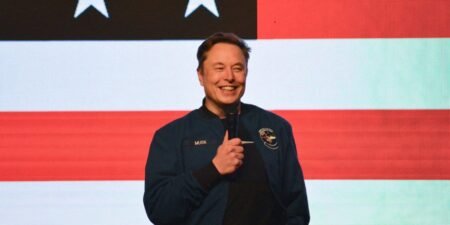It turns out Elon Musk might be on to something with his retro-futuristic Tesla Diner.
With sci-fi classics playing on giant drive-in screens, servers dashing by on roller skates, and EVs and robotics on display, the Tesla CEO appears to have cued into something ultra-trendy.
Industry insiders told Business Insider that in the next few years, many eateries will be cashless, use robots for customer interactions, and lean into old-school design elements. So while every restaurant won’t be a clone of the instant West Hollywood landmark, Musk’s latest business venture will fit right in.
“I think we’re going to start to see more restaurants that are sort of like time capsules, where there’s this interesting reinterpretation — futuristic, but with this nostalgia to it,” Alexis Readinger, founder of Preen, Inc., an architecture and design studio that specializes in hospitality design, told Business Insider.
Readinger is already designing restaurant concepts that fit the bill by pairing romantic reinterpretations of vintage design with “techno-apocalyptic shadow” elements. Think midcentury modernism meets “Mad Max,” or Hollywood Regency mixed with “Blade Runner.”
The trend offers customers a way to enjoy both classic and fresh design elements, Readinger said, allowing patrons to live out spacey cantina fantasies — like being served drinks by a humanoid robot — while falling back on the familiarity and comfort of classic pleather booths and checkered floors.
And droids are definitely allowed in these establishments: At the Tesla Diner, an Optimus robot served popcorn to guests, though the staff gave mixed reports about whether it had a human operator. Kura Sushi, an interactive conveyor-belt restaurant that gamifies your dining experience with collectible swag, has bots that deliver drinks and specialty orders. Chipotle rolled out and is refining its Autocado robots, which cut, core, and peel avocados for guacamole, while McDonald’s first robotic restaurant opened in 2023.
“Fast casual and fast food will definitely optimize — that’s where the largest amount of automation with robotics is going to happen,” JP Lacroix, president of the branding firm and design agency, SLD, told Business Insider. That’s because, for consumers in those categories, value comes from how quickly and cheaply you can be served a filling meal, he added.
Trending now: dinner
Advancements in artificial intelligence, combined with burgeoning sentiment analysis — which uses AI to determine your mood and how to respond to you based on the tone of your voice and other context clues — will make it easier for human hospitality staff to ensure your night out is one to remember.
Right now, sentiment analysis is being deployed widely in banking and customer service fields, usually in automated telephone lines, Lacroix said.
Think about that the next time you scream “representative!”
“So if you’re really upset, the system will pick up on that, and they won’t make you wait,” Lacroix said. “At restaurants, they’re going to be able to analyze that you’re coming in for a birthday party and decide: how do you experience that? That shareable, memorable experience for a birthday party is a very different experience than if you’re going on a date for the first time.”
For back-of-house staff, deploying artificial intelligence to analyze data, such as purchasing details, rates of food spoilage, and consumer trends, is also already leading to new menu innovations, Bo Davis, CEO of restaurant tech company MarginEdge and founder of WasabiSushi, told Business Insider.
Imagine what a chef could prepare, knowing strawberries are on sale and the filets need to be eaten by the next dinner service. Add whatever’s trending on TikTok, and you’ve got that night’s special.
‘Can (A)I take your order?’
Ordering kiosks are already the norm at fast-casual chains, and downloading menus or making payments via QR code is a popular method at other locations. But with advancements in AI scaling rapidly, ordering and payment systems are on the brink of a total overhaul.
Steve Carlin, CEO of AiFi, told Business Insider that cashierless transactions are becoming increasingly accessible through improvements in spatial AI. His company uses camera systems no more obtrusive than existing security cams to help retail spaces and restaurants track and predict consumer behavior — so you can walk into a quick-serve location like Starbucks, grab a pre-made meal or drink, and walk out without needing to swipe your card at all.
AiFi’s camera-only checkout system is already in place at Nissan Stadium, home of the Tennessee Titans. Whole Foods has its own cashierless checkout technology, requiring just a scan of a customer’s palm to accept payment. Carlin said similar tech is being adopted in the restaurant industry now.
And AI will soon be the norm for taking orders at fast casual and quick service restaurants, the experts told Business Insider.
Krishna Gupta, the cofounder of Presto, an AI-driven automation provider for drive-thru restaurants, told Business Insider he expects there to be no human operators taking orders at drive-thrus within the next three years. The technology is already being rolled out at major chains like Carl’s Jr. and Hardee’s.
These advancements might not take over the industry overnight, but they’re steadily gaining ground, moving from test runs to wider adoption, simmering toward the mainstream before most diners even realize the heat is rising.
Justin Falciola, former CTO at CKE Restaurants and Papa John’s, is now president of the digital food sales software Deliverect. He told Business Insider we’re just scratching the surface of how AI and other tech innovations will reshape the average dining experience.
“We’re in this moment, and things are moving so fast — it’s kind of like when the iPhone appeared, and three years after it appeared, you’re like, ‘Did that just happen?’ — I think we’re literally in that moment in the restaurant industry,” Falciola said.
Printers in the kitchen
If robot servers and AI order-takers aren’t futuristic enough, just wait until chefs start printing your dinner.
“The 3D printing you see in ‘Star Trek?’ You know, where they punch buttons in and food comes out? That’s doable now, it’s just not cost-effective,” Lacroix said.
Two-dimensional edible printers already exist at a commercial scale, capable of printing images on food items with edible ink. Multiple healthtech start-ups and major institutions, including NASA, are exploring ways to scale up 3D printing technology to manufacture meals using edible filaments so the tech can be used for long-duration space missions and other applications.
Several companies, such as Nanotronics and MatterShift, are working on technologies that can rearrange particles to create anything from food and drink to fertilizers and batteries.
“Talk about customization to the nth degree,” Lacroix said. “They’ll be able to print your steak, cook it at the temperature you want, with the right amount of fat for you.”
Retro looks. Robot cooks. Food: the final frontier.
Read the full article here

